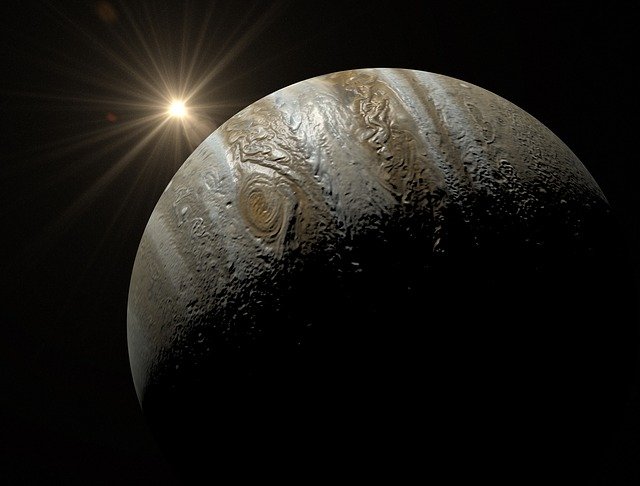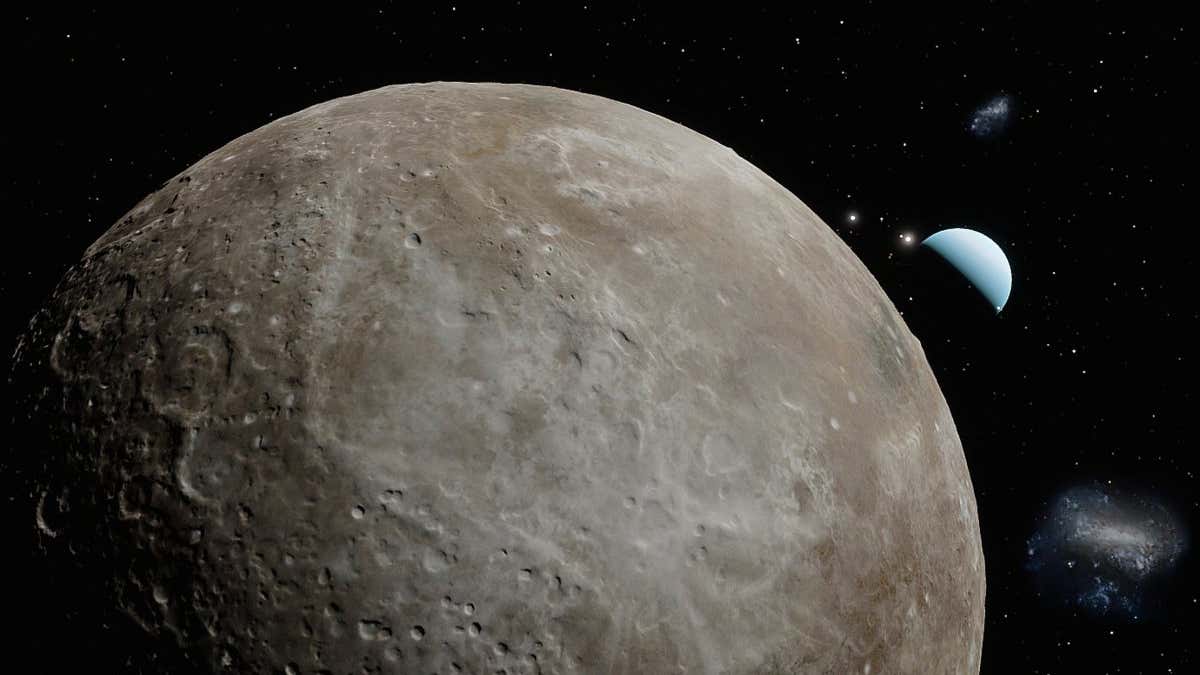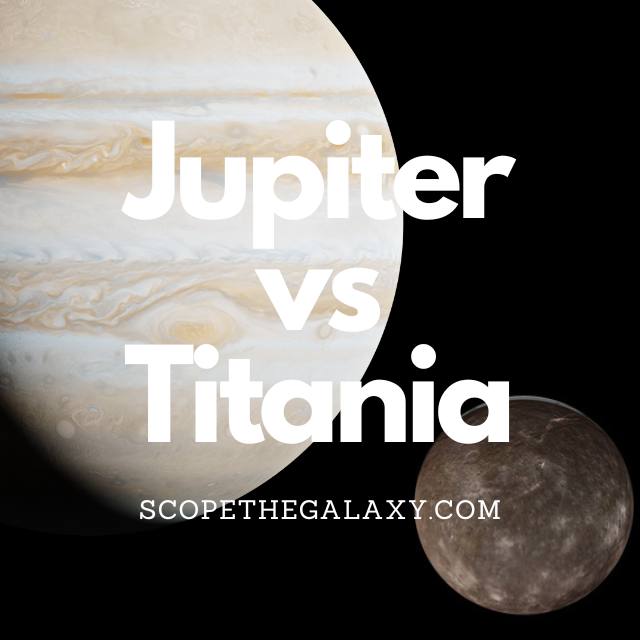*This post may contain affiliate links. This means we may make a commission if you purchase an item using one of our links*
The main differences between Jupiter and Titania is that Jupiter is a gas giant planet with 79 moons whilst Titania is a natural satellite the orbits Uranus, Jupiter is around 90 times the size of Titania in diameter and has the strongest magnetic field in our solar system whereas Titania doesn’t have a magnetosphere.
There are various other differences between the two so, continue reading for a more detailed look at each body along with their similarities and differences below.
What Is The Planet Jupiter?
Table of Contents

Jupiter is the 5th farthest planet from the Sun and the largest planet within our local solar system. The planets most recognizable trait is the giant red spot visible on its atmosphere along with the brown horizontal bands flowing across its atmosphere.
As a result of its composition and size, Jupiter falls under the classification of a gas giant.
This is because its composition mostly consists of the elements hydrogen and helium. The split is roughly 71% hydrogen, 27% helium, with the remainder of the elements split throughout the left over 2%.
As the biggest planet in our solar system, Jupiter is 139,820 km or 1,300 Earths in diameter, it has a mass of around 0.001 solar masses, the temperature when inside the clouds are roughly -145 degrees Celsius whilst the core is far hotter, equating in the region of 24,000 degrees Celsius.
Due to its extreme circumstances, gaseous composition and distance from the Sun, the planet is not theoretically capable to support life, from its subzero temperature to the extremely fast 640 km/h winds, and its gravity which may be unsustainable for our bones, roughly 2.4 times greater than Earth’s.
Although the conditions on Jupiter aren’t suitable for us, some of its 79 moons like Europa for example could support life.
This brown giant has a relatively fast rotation around its axis where 1 rotation typically takes 10 hours to make whilst its orbit around the Sun is far longer taking in the region of 12 years for 1 full cycle.
Another feature of Jupiter that is renowned by astronomers is the strength of its magnetic field. In comparison to the other planets in our solar system it is even stronger than our Sun, where it’s over magnetosphere is roughly 20,000 times the strength of Earth.
What this means is that Jupiter’s magnetosphere is able to avert solar winds that are 3 million kilometers away from it.
What Is The Moon Titania?

Titania is the biggest of Uranus’s moons, with a circumference of 4,956km and a diameter of 1576.8km.
The high density of this moon suggests that it most likely formed from a collection of dust and debris leftover from the formation of Uranus or from the debris created in the collision that reportedly tilted Uranus onto its side. As a result Titania has a mass of 3.4 × 10^21 kg.
First discovered on 11th January 1787 (the same day as the discovery of Oberon, the second biggest moon of Uranus) by British astronomer William Herschel, the name “Titania” comes from the Shakespeare play, A Midsummer Night’s Dream. (Most of Uranus’ moons are named after Shakespeare’s characters.)
Having observed Titania for many years, scientists theorize that its composition is likely to be equal parts ice and rock, the latter of which may contain carbonaceous materials and organic compounds.
Research suggests that the moon most likely has a rocky core (accounting for 66% of the moon’s radius) and an icy mantle. If the mantle contains ammonia, it will act as antifreeze and make it possible for liquid water to exist. In this instance, the moon could possess a layer of liquid ocean around 50km thick.
Titania tilts slightly towards the equator of Uranus and is tidally locked to its planet. This means a Titania day is 8 days and 17 hours which would be the same for its orbital cycle.Titania has an average temperature of -203 degrees Celsius.
The planet Uranus is also tilted, with the moons orbiting on the equatorial plane, giving it extreme seasons. On Titania, the north and south poles experience 42 years of complete sunshine followed by 42 years of total darkness.
Scientists have observed the presence of large amounts of carbon dioxide, suggesting this may be the primary component of this moon’s atmosphere. Thanks to the tilted orbit, and a concentration of solar radiation from the poles, Titania probably maintains a carbon dioxide cycle, similar to the hydrogen cycle on Earth.
Similarities Between Jupiter And Titania
There are a few similarities that Jupiter and Titania share, which in this case includes the following:
- Both are a spherical shape.
- Both have a hotter core.
- Both are part of the same solar system.
- Neither have tectonic plates.
- Both orbit another object.
Differences Between Jupiter And Titania
In regards to the differences between the two, they include the below.
- Titania orbits Uranus whilst Jupiter only orbits the Sun.
- Jupiter has 4 rings surrounding it whilst Titania has 0.
- Jupiter is a gas giant whilst Titania is a terrestrial based natural satellite.
- Jupiter has 79 moons whilst Titania has 0.
- Jupiter has a diameter of 139,820km whilst Titania’s diameter is 1,576.8km.
- Titania has a very thin exosphere composed mostly of carbon dioxide whilst Jupiter is gas based, composed mostly of hydrogen and helium.
- A day on Titania takes 8 days 17 hours whilst a Jupiter day takes 10 hours.
- It takes Titania 8 days 17 hours to orbit Neptune and around the Sun in 84 years whilst Jupiter orbits the Sun in 12 years.
- Jupiter has an axial tilt of 3.13 degrees whilst Titania’s axial tilt is closer to 0.
- Titania’s average temperature is around -203 degrees Celsius whilst Jupiter has an average temperature of – 145 degrees Celsius.
- Jupiter’s density is 1.33 g/cm³ whilst Titania’s density is 1.71 g/cm³.
- Jupiter mass is 1.898 × 10^27 kg whilst Titania’s mass is 3.4 × 10^21 kg.
- Titania’s gravitational strength is 0.367 m/s² whilst Jupiter is 24.79 m/s²
- Titania is tidally locked to Uranus whilst Jupiter is not tidally locked to any entity.
- Jupiter has the strongest magnetosphere in our solar system whilst Titania does not.
- Titania may have water within its surface.
Summary
Jupiter and Titania share very few similarities between themselves, such as the fact both are part of the same solar system and neither have tectonic activity on their surfaces but, they are definetly more different than they are similar.
Whether it be in regards to mass, size, physical composition, orbital period, density, magnetic field and more, which is why Jupiter is very distinct in its functions, especially when compared to the far smaller natural satellite Titania.

